Having a sushi knife or a sashimi knife as part of your kitchen cutlery set is an exciting way to introduce Asian cuisine into your home. These knives come in different styles, some with a unique Japanese design and others with a more Western flair.
Sushi and sashimi knives are specially designed for cutting fish, vegetables, and sushi or sashimi rolls. They are sharper than standard chef knives and have a flexible blade for easy slicing. Most of these knives are single beveled, while the other blade side may feature a slightly concave edge to aid food release when cutting.
This article will discuss all you need to know about sushi and sashimi knives, a brief history, types, and their uses.
Table of contents
History of the sushi knife
Sushi knives originate in Japan, with most handcrafting techniques dating to the 14th century. Swords smiths of the time were responsible for developing Samurai swords and knives. During the 19th century, Japan experienced a modernization, upon which the government enforced the prohibition of carrying Samurai swords.
As such, many artisans resorted to making sushi knives instead of swords. Notably, every art form in Japan has thousands of years of history that come into play in its design, and the sushi knife wasn’t an exception. The artisans used many of the sword-making techniques and designs in creating sushi knives, resulting in the sushi knives we know today.
Sakai city was a place that played a massive role in the development of sushi knives. It’s world-renowned for its traditional metal works passed down through generations dating back to 500 A.D. The production of high-quality sushi knives influenced Western culture, becoming one of the symbols of Japan’s healthy cuisine.
Parts of a sushi knife
The main parts of the sushi knife include:
- The cutting edge (kireha)
- The tip (kissaki)
- Spine (mine)
- Chin/heel (Ago)
- Handle
As with the parts of a kitchen knife, the sushi knife consists of the cutting edge – the part that does the actual cutting. Sushi knives are single beveled, which means that only one side of the blade is fully sharpened, while the other side features a slightly concave edge to aid food release when cutting.
For a right-handed person, the cutting edge is on the right side of the blade, while it is on the left side for a left-handed person. The tip or the kissaki is the sharp-pointed part of the blade, while the spine is where you rest your index finger for better grip.
The chin or heel is the part of the blade closest to the handle. It’s the thickest part of the blade that minimizes damage when cutting hard objects. The wooden handle provides grip and makes it easy to maneuver the knife.
Handpicked for you
True cutting power in the palm of your hand
Different types of sushi knife
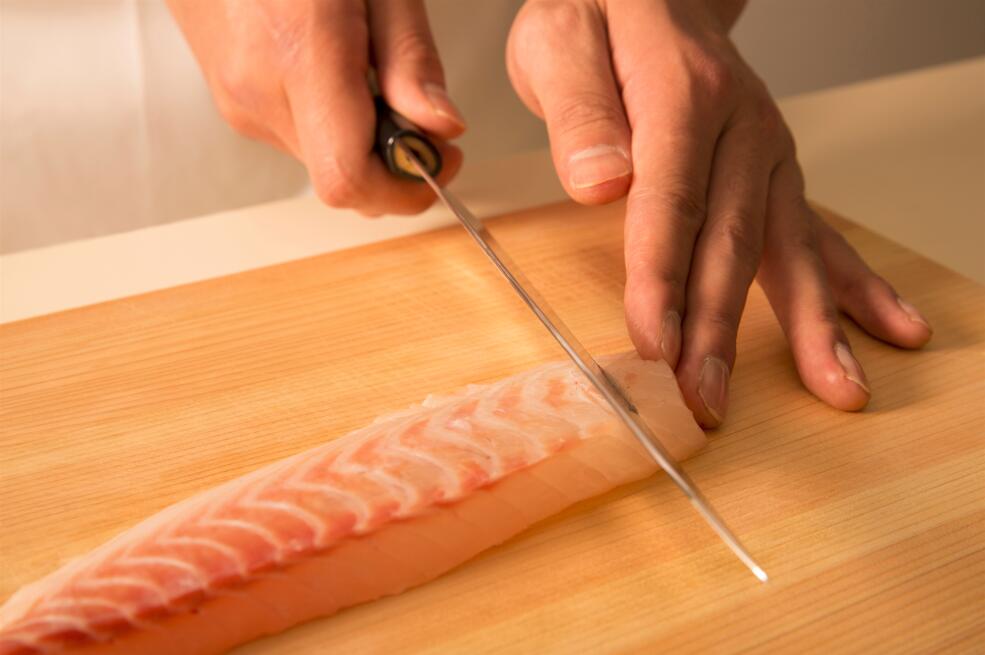
There are many different types of sushi knives. Each of these knives boasts features that make them suitable for specific tasks. Sushi knives can be differentiated by features such as blade construction, handle material, and blade length.
Below is a detailed look into the different types of sushi knives, their features, and their uses.
Yanagiba
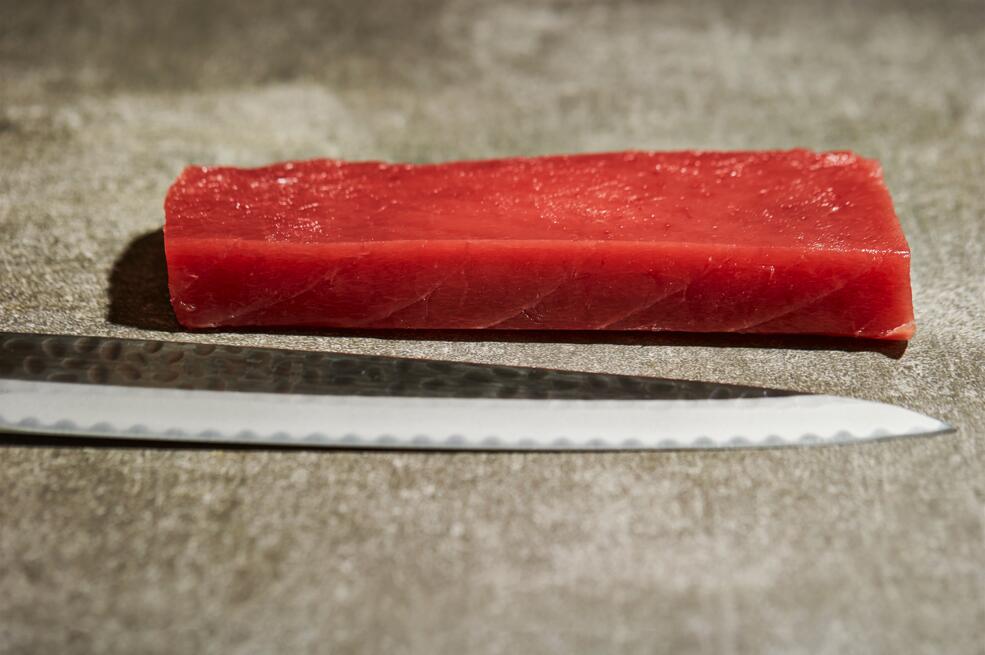
Yanagiba in Japanese means “willow leaf blade.” It’s a traditional Japanese-style sushi knife measuring about 210mm-360mm. Those from the Kansai region would sometimes refer to this knife as the “Shobu,” which translates to “iris leaf. ” This name comes about because it resembles the Japanese iris plant, which has spear-shaped leaves.
Features
- The Yanagiba features a narrow but long blade with a pointed tip. The blade is thin to achieve clean cuts, perfect for slicing boneless fish filets.
- It has a unique single bevel ground on the right side, with a slightly concave edge on the left side.
- This combination prevents the blade from sticking and allows delicate fish slices to fall away easily. The shape of the blade also allows for a smooth cut on the fish’s skin without damaging it.
- Most Yanagiba sushi knives feature a wooden Wa-Handle for better grip. Some Wa-Handles may be oval or octagonal, but most knives feature D-Shaped handles.
Uses of the Yanagiba
The Yanagiba Sushi knife is best suited for slicing raw fish and boneless filets of fish. It’s an ideal knife for preparing sushi and sashimi dishes, where clean cuts are an essential part of the dish.
Using the Yanagiba sushi knife requires understanding the proper technique. Some techniques you can use include:
- Usuzukuri: This style essentially means “fine cuts.” Sushi chefs use this technique to produce extremely thin slices of raw fish. Slicing the fish in this manner emphasizes how translucent white fish is and allows chefs to note the bouncy texture of white fish.
- Hirazukuri: This style is when chefs pull-cut perpendicularly on the fish’s body, allowing them to get long and thin slices of fish. Chefs use this style on fatty fish such as tuna and salmon.
- Sogizukuri: Pull-cutting at an angle of about 45 degrees and in the direction of the fish’s skin or scales. This technique results in slices that are thick but long. Slicing salmon this way makes Sushi more attractive and enjoyable to eat.
Deba

Deba is a sturdy Sushi knife designed with a thick spine, a sharp edge, and a pointed tip. As with most Japanese kitchen knives, it’s single beveled, or one side of the blade is ground completely flat. The spine is thick, making it more durable and less susceptible to damage when cutting through thick flesh.
This knife is significantly heavier than other Sushi knives and has a wide asymmetrical blade. It’s long enough, measuring about 150-330 mm, but most chefs recommend using one measuring about 180mm. Variants of the Deba knife include Ko-Deba, Ai-Deba, Yo-Deba, Kanisaki-Deba, and the Mioroshi-Deba.
Features
- The true Deba knife has a sharp, tough blade. The thickness measures about 5-9mm thick, which improves its balance on hands, especially when cutting off fish heads.
- The blade is wide at the heel and tapers towards the cutting edge. It has a long blade and a sharp tip. Sushi chefs recommend a Deba Knife with a blade length of about 180mm.
- Most feature high carbon steel blades that ensure high durability.
- It features a Wa-Handle which can either be D-shaped, oval, or octagonal.
Uses of the Deba knife
The Deba knife is an ideal knife for working with the whole fish. Chefs use it to behead fish, cut through bones, and filet fish. Because of its weight, some chefs use it to break through small bones and flesh in poultry.
However, it’s’ not an ideal knife for cutting through rigid bones as the blade may become chipped or broken.
The pointed tip is ideal to feel the bones before fileting the fish. It also has a sturdy heel that allows easy removal of the tail and the fish head without causing any damage to the blade.
The center of the Deba blade is thick, making it more durable and less susceptible to damage when cutting through thick flesh. You can also use the center part to remove the skin, filet the fish, and slice tiny through bones.
Kiritsuke
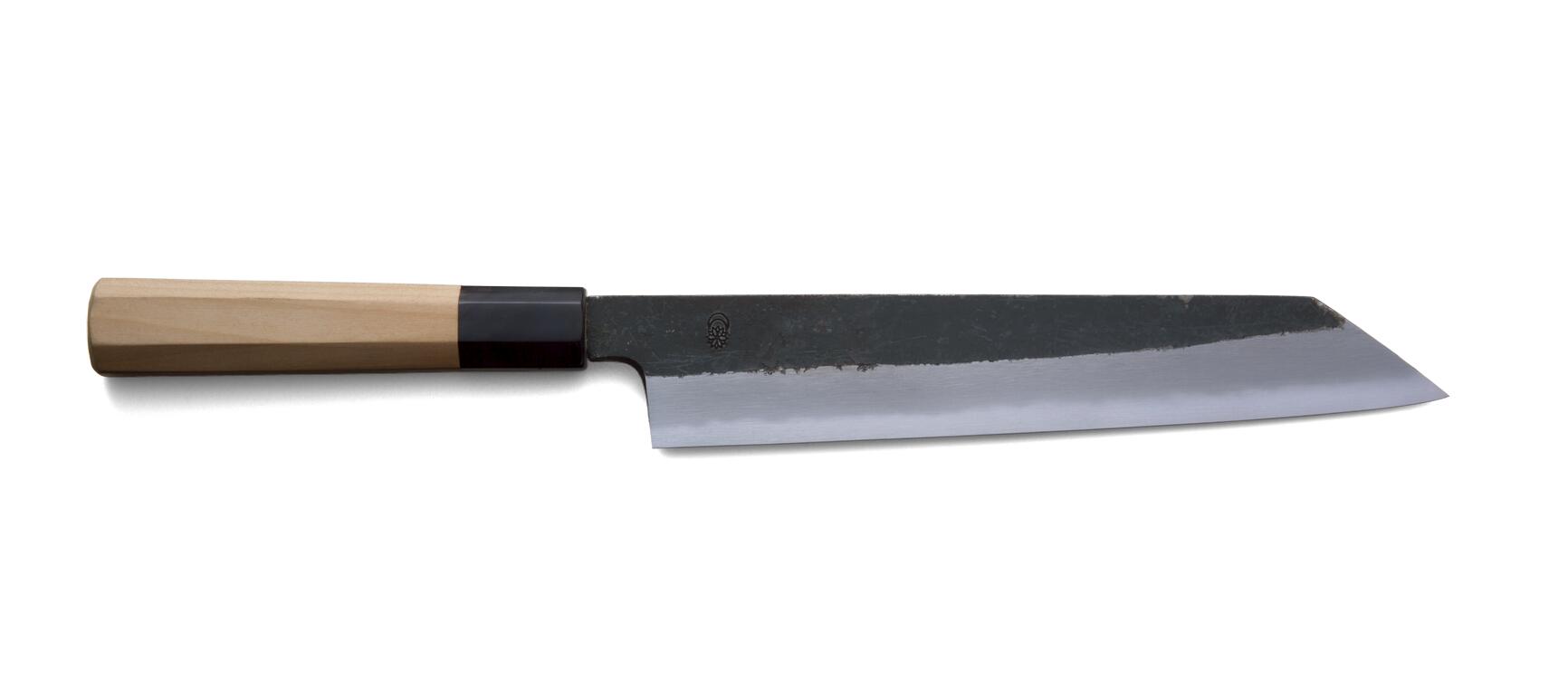
Kiritsuke is a Japanese word that translates to “slit open.” It’s considered a hybrid knife between the Usuba and the Yanagiba. The knife measures between 240-330mm, but most chefs recommend using one that measures 270mm.
The combination of a Yanagiba and an Usuba creates a very versatile Sushi knife. Its multipurpose characteristics make it ideal for cutting vegetables as you would with an Usuba knife or filet fish like you would with a Yanagiba. The kiritsuke knife is a status symbol for Sushi chefs because of its considerable weight, balance, length, and thickness of the blade.
Features
- The blade has a sword-like appearance with a clip point tip. Its straight edge blade enables Sushi chefs to make clean cuts, especially when fileting fish.
- It has a flat heel section that makes it ideal, especially when using the push-cut technique.
- It has an angled tip ideal for making straight cuts, significantly when cutting through bones or fileting fish.
- The knife has a single bevel edge that is sharp and stiff.
- It has a flat section of the spine which leads the knife up to the tip, where it curves.
- It comes with a Wa-Handle that is either D-shaped, oval, or octagonal
Uses of a Kiritsuke knife
A Sushi chef can use a Kiritsuke knife to filet, cut, and slice small items. Because of its versatility, you can also use it to cut vegetables or debone poultry. Chef’s use it as a sushi knife or a sashimi knife to prepare sushi or sashimi.
The kiritsuke isn’t an easy knife to use, which is why Sushi chefs undergo extensive training before they can use it properly. It takes a lot of practice and patience to master the use of this knife. The pinch grip, the angle of the blade, and the grip on this knife are all essential factors to ensure its safety.
Usuba Knife
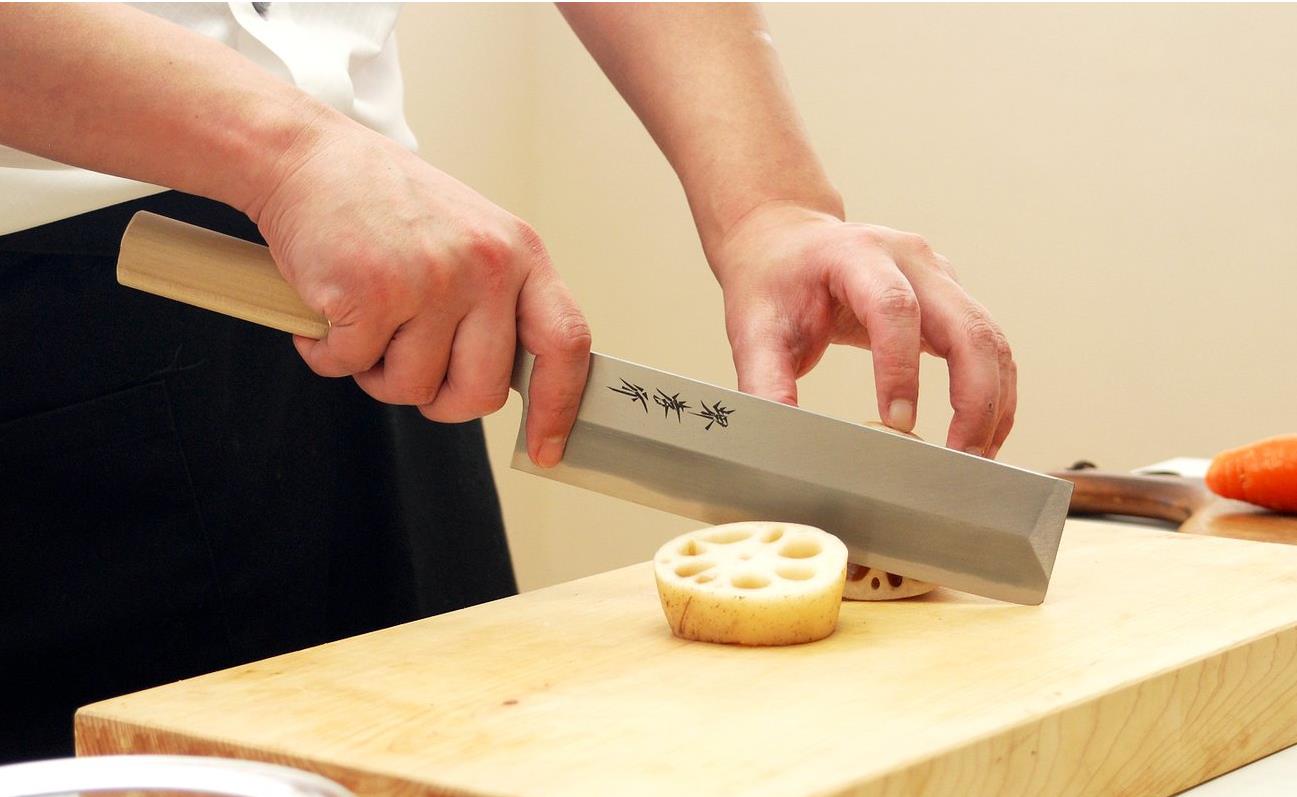
Usuba knife, which loosely translates to “thin knife,” is a traditional Japanese Sushi knife with a thin blade and sharp edge. Its handcrafted design makes it ideal for chefs who want a Sushi knife that is comfortable to use and easy to maneuver. The knife is thin and features a rectangular shape with a straight-edged blade.
Features
- It features a long flat blade with a straight edge that makes a complete contact on the cutting board. This feature makes it ideal for cutting vegetables and nori sheets.
- The thin blade is ideal for cutting thinner pieces of vegetables, fileting fish, and cutting ingredients. It is designed to let the users apply pressure on these ingredients without compromising their safety.
- It comes with either an octagonal, round, or d-shaped octagonal Wa-Handle
- The blade is thin and sturdy to ensure precise cuts
- It’s also sharp, which makes it ideal for cutting through small bones, making crosscuts on fish, and slicing vegetables without tearing
Uses of an Usuba knife
The Usuba knife, also known as the vegetable knife, is a great Sushi knife for a Sushi chef who wants to make precise cuts. The thin blade makes it easy to cut through vegetables without destroying them in the process. You can use this knife when preparing sushi or sashimi servings.
Using a different Sushi Knife is ideal for making distinct cuts for decorative purposes. If your restaurant is known for its artistic sushi presentations, you can use this knife to create decorations with different ingredients.
The Usuba knife isn’t the easiest one to use, especially when starting. It’s a knife for skilled sushi chefs who know the craft and have mastered several types of Sushi knives. You need a lot of precision and a heightened sense of timing when using this knife.
Sushi knife vs. sashimi Knife
When it comes to Sushi knives, there is a lot of confusion among chefs and novice users. One common question they ask: “What is the difference between a Sushi knife and a sashimi knife?
The terms “Sushi” and “Sashimi” refer to two different ways of preparing raw fish. When preparing sushi, you need to make precise cuts to maintain the ingredient’s integrity. A sushi knife is more versatile, making it useful for cutting vegetables, fish, and sushi rolls.
Sashimi knives, on the other hand, have a more specific purpose. Sashimi is thinly sliced pieces of raw fish arranged on a plate for presentation purposes. As such, Sashimi knives are only ideal for cutting raw fish. Sashimi knives are thinner, allowing Sashimi chefs to cut through raw fish easily without compromising the quality of its texture.
Western knife vs. traditional Japanese sushi knife
The main difference between western knives and traditional Japanese sushi knives lies in the design of the bevel. Western-style knives are double beveled, while Japanese sushi knives are single beveled. In a basic sense, Western knives are sharpened on both sides of the blade, while Japanese knives are sharp on one side.
The table below illustrates the differences between Japanese sushi knives and Western knives.
| Western knife | Japanese sushi knife |
| Double beveled | Single beveled |
| Curves along the blade | Feature a straight blade (blade is rarely curved) |
| Bevel angle between 18-20 degrees | Low bevel angle upto 5 degrees |
| The cutting edge isn’t as sharp | The cutting edge is extremely sharp |
| They can cut through tough chicken bones | Cutting through tough ingredients can ruin the blade |
While the above differences stand, it’s important to note that there are no strict rules in sushi or Japanese cuisine. You can use Western knives for sushi, but this practice is uncommon in Japanese culture. Sashimi isn’t restricted to Japanese chefs either; French and other European cultures use this culinary technique.
What is the best sushi knife?
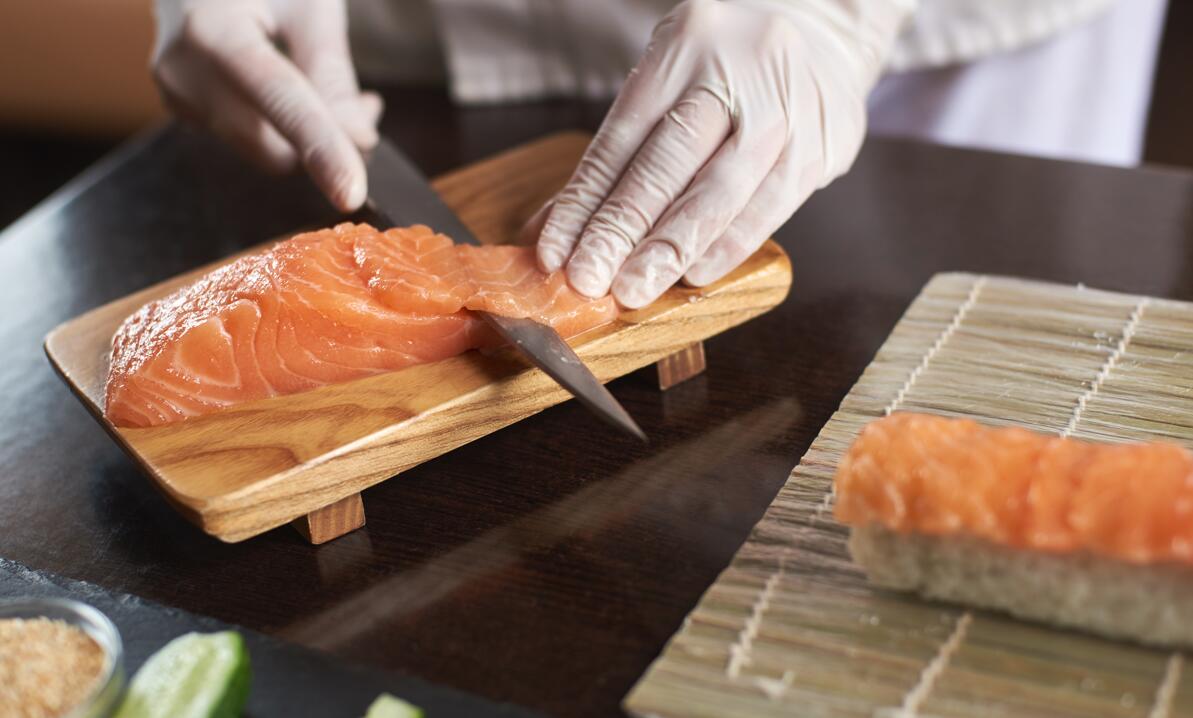
The best sushi knife fits the chef’s skill and personal preferences. It should be sharp enough to make precise cuts but heavy enough to handle tough ingredients. One with a thin blade will help you slice through raw fish for sashimi, but a thicker blade might be better if you plan to cut through tough ingredients.
Most Chefs recommend using Yanagiba sushi knives for slicing through raw fish. It features a thin blade that makes it easy to cut through ingredients without compromising quality. As with most Japanese knives, it’s single beveled and features a straight blade.
Sorry man, I’m going to find a solution to the internet now. Talk to you later, you can update the articles to the doc tho I’ll read it anytime.
How to care for sushi knife
Unlike Western knives, Japanese knives are more delicate. They are designed with extremely hard steel and feature sharp blades. As such, any contact between the blade and stones, bones or metal can ruin your knife. It’s also important that you sharpen the sushi knife the right way to avoid ruining the blade.
You shouldn’t use the sushi knife on frozen fish or cut tough bones as this practice can dull the blade. Some sushi knives can be dishwasher safe, but it’s best to wash them by hand.
Also, do not twist the blade when removing the knife from raw fish. Doing this will ruin the blade and more than likely cause it to bend. Since Japanese knives have thinner blades, they are more likely to break. Be extremely careful when handling the knife, and it should last for many years.
How to sharpen a sushi knife
Using a whetstone is the best way to sharpen a sushi knife. A whetstone will give the blade a precise, sharp edge ideal for cutting raw fish.
Follow these steps to sharpen a sushi knife:
- First, you need to choose the right whetstone. Depending on the damage on the sushi knife, you’d need to select a coarser or finer stone.
- Soak the stone in water for 10 minutes. Soaking the stone in water increases friction, improving the sharpening process.
- Place the whetstone on a flat surface. Make sure to place it on a secure surface.
- Hold the knife with your dominant hand so that the blade faces away from you. Ensure that the blade is placed on the whetstone at roughly 15 degrees.
- Grip the whetstone and move it back and forth across the blade with your other hand. Sharpen each side of the blade until you feel a burr.
- If the blade is sharp, use your thumb to flick off the burr. If you feel no burr, place the knife back on the whetstone, spacer out, and repeat steps 4-6 until you feel a burr.
- Polish the blade with a clean cloth to remove any residue.
Closing
A sushi knife and a sashimi knife are two of the most important knives in Japanese cuisine. Both have a thin blade and can be used to cut raw ingredients. However, they are differentially designed to cut through specific ingredients. A sushi knife is more versatile while a sashimi knife is only ideal for cutting raw fish.
Visit our site for high quality chef knives that will change your entire cooking experience.












